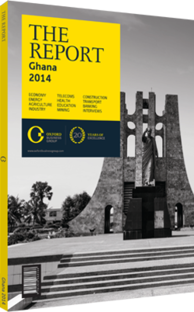Production and margins rise and fall with the price of gold
The decline in the global price of gold in 2013 came as costs continued to rise. The resulting squeeze had a significant impact on Ghana’s mining industry, which launched a programme of rationalisation. The stable prices of the following year were too low for some Ghanaian operations to continue, though cost pressures eased. If the gold price rises once more, the leaner sector should be in a good position to capitalise.
The cost of producing an ounce of gold in Ghana rose 18% in 2013 to $951, according to the Ghana Chamber of Mines (GCM). It said that this was the highest cost increase in the world. Using a broader definition to include depreciation, depletion, amortisation and cash expense, Ghana’s all-sustaining gold cost stood at $1378, 38% above the global average of $997. The average “all-in” cost, a metric used by gold consultancy GFMS to include “ongoing all-in sustaining, capital, indirect and corporate costs”, was $1473 in Ghana, above the global average of $1350. The GCM is thus right to note that Ghana is an expensive jurisdiction for gold mining. “Rising costs in recent years include inputs like cyanide, electricity, taxes and wages in Ghana – the minimum wage is now $500 a month,” Toni Aubynn, CEO of the Minerals Commission, told OBG when he was the CEO of the Ghana Chamber of Mines. “The rising gold price dragged up costs along with it.” Also, according to Kwame Addo-Kufuor, vice-president of corporate affairs at AngloGold Ashanti, “Lower gold prices have different implications for various mines across the region. Higher-grade, low-cost operations generally fare better than low-grade mines which have not developed the systems and structures to control all-in costs. Fiscal regimes also play a role, with mines in higher-tax environments more likely to struggle.”
Changing Strategies
The downside was that some mining operations had to be curtailed, causing output to fall below potential. On the upside, mines should emerge leaner and more efficient when suspended operations resume. Companies are being less speculative and holding less inventory, while at the same time reviewing their technologies and switching to more cost-effective and efficient methods. “The downturn in the market brought in its wake a period of re-examination for mining firms, during which they sought to become less speculative and hold less inventory,” Aubynn said. “This critical examination included a review of technology and a switch to more cost-effective and efficient methods.” Sector leader Gold Fields, for example, restructured its Damang and Tarkwa mines. Three production units at Tarkwa were closed; the life of mine at Damang was reduced to six years (taking it to 2019) by the exclusion of one pit cut-back, which the firm said “is not viable in its current configuration and at a $1300/oz gold price”. AngloGold Ashanti started a strategy change at its Obuasi mine. In May 2014 industry sources reported a “retrenchment” of 6000 staff for 18-24 months while the mine was overhauled.
Labour
The 2013 squeeze put serious pressure on players to rationalise the costs they could control, including labour. In April 2014 the GCM estimated that some 3000 workers were laid off. Labour relations have been strained in the sector, which is both cyclical and subject to pressure from unions, with costly redundancy packages. However, employers’ active engagement with the Ghana Mine Workers’ Union and the union’s participation in compensation processes has greatly eased the process of rationalisation. Gold Fields would certainly consider recommencing halted operations at Damang if the market conditions were better – for example, if costs stay around the current level and prices rise. Price rises need not be matched by rising costs, so margins could widen and profitability improve. But miners are also wary that tax increases would offset some of the benefit of price rises.
The broad expectation is that the price of gold will rise again. According to Gold Fields Ghana, the price of gold during late 2014 and early 2015 is expected to hover around $1300. There is confidence in the longer-term potential for the commodity’s price to recover, particularly in light of the high demand from Asian investors.
You have reached the limit of premium articles you can view for free.
Choose from the options below to purchase print or digital editions of our Reports. You can also purchase a website subscription giving you unlimited access to all of our Reports online for 12 months.
If you have already purchased this Report or have a website subscription, please login to continue.

